Tale of the Mask: The Story behind the Chhau Dance

By Indranil Mukherjee
Curator: Indranil Mukherjee (Founder, VIBGYOR, www.infovibgyor.com)
Contributors: (1) Abhijit Mondol, (2) Dipak Das, (3) Nilendu Barai, (4) Soumya Dev Chandra, (5) Sudip Biswas, (6) Sujit Sarkar
Mentor: Probir Saha
Location: Purulia District, West Bengal
Introduction
One could not ignore the attention drawn by those vibrant colourful masks and the glittering ornaments worn by the performers of the Chhau Dance. They were so eye-catchy that most of us purchase one sample to decorate our house, adding a new dimension to the classy aesthetics of an interior. In recent times, we found its prominent presence in the blockbuster Bollywood film, Barfi, where the key character in the film had donned such a mask to escape from police.
But it is not just a mask. It’s much more than just a colour, a prop, a decorative or a movie sequence agenda. It has its own story. Chhau Dance is a semi-classical Indian dance with martial, tribal, and folk origins from the Eastern Indian states such as West Bengal, Odhisa, and Jharkhand. According to its origin, we have three forms of Chhau folk dance: the Purulia Chhau of Bengal, the Seraikella Chhau of Jharkhand, and the Mayurbhanj Chhau of Odhisa. In this essay, we are about to showcase the first kind, from Purulia, West Bengal.
The Purulia Chhau uses extensive masks, shaped in the form of character played. These masks are crafted by potters. Chhau dance is regionally celebrated particularly during spring every year. The dance form is a perfect blend of classical Hindu dances and the traditions of ancient regional tribes. The dance is meant for an all males troupe, performed at night in an open space, which they call Akhada or Asar. The dance is rhythmic and set to traditional folk music played on reed pipes – Mohuri and Sehnai. A variety of drums accompany the music ensemble including the dhol (a cylindrical percussion instrument), dhumsa (a large kettle drum) and kharka or chad-chadi. The themes of the act include local legends, folklore, and episodes from the Ramayana and Mahabharata, or any other ancient abstract or mythological theme.
Concept
In November 2017, VIBGYOR organized a Photographic Tour to Purulia, to document the Tale of the Mask, its preparation and use, and an act of Chhau dance. Our intention was not just photography, but to explore the lifestyle, to add emotions to the photographs shot. So, we planned to take the team to their village, and stay with them to know them even better and gather more information.
A group of performers was in contact with us, prior to the event. They were asked to meet us at the banks of the Bagmundi River for a performance, exclusive for us. Thereafter, we visited the villages, where they stay, and where the potters prepare the masks. What we got is a visual treat, which narrates the story on its own, without any help from the ‘civilized’ world, its literature or any language. We hereby present to you a short pictorial saga, ‘Tale of the Mask’.
Experience
As per schedule, we found a truck arriving at the Akhara set beside Bagmundi River. There were team members of different age. Excitement reciprocated immensely from ends as the teams met: the photographers and the performers. They carried all their ornaments, make-up kit, dresses and masks at the bank of the river to get ready for the show. Soon, we found them transformed into vibrant characters. As a safety measure, they wore special knee cap and ankle socks. Their ornaments had Mukut (crown), Buk-Peti (Chest Wear), Komor-Belt (Waist belt), and many more.
Just as the sun was about to resign for the day, showing its golden rays, the performance flagged off. Each team member had responsibilities of their own. As few were performers, others were beating the drums, playing the flute and sehnai. The liver performance soon gained additional momentum with summersaults and rapid movements and dance steps. The drum beats kept increasing, forcing all the viewers to tap their feet, add clapping, a chill running down the spine.
The dance is not just vibrant, but it soon connects you to the root. The energy level is too high and thrilling. No matter how long it runs, the viewer never feels like stopping it. But, finally, after one full act of Chhau Dance, all the performers took a break to bow and greet the viewers.
Finally, they unmask themselves, and we realize that all those whom we thought to be the gods and goddesses, or the Evil Asura, are all humans, just like us. We realise, that god is within the humans. All good, bad, and the evil are within us. We need to understand, analyse, and act to uphold the positives, and dodge the negatives.
Next day, we visited the village. The villagers out here are mostly potters. They primarily prepare the masks to be used for the Chhau dance. The masks are prepared in accordance to the characters to be played. Apart from the masks to be used for their act, there are also small masks prepared. They sell these to the tourists. They were so eye-catching that most of us purchased one sample of it for us.


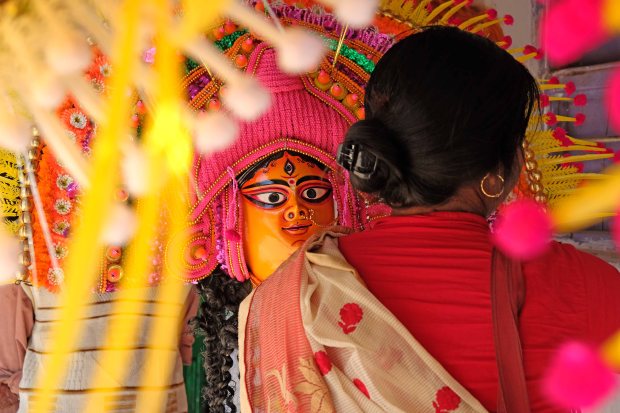
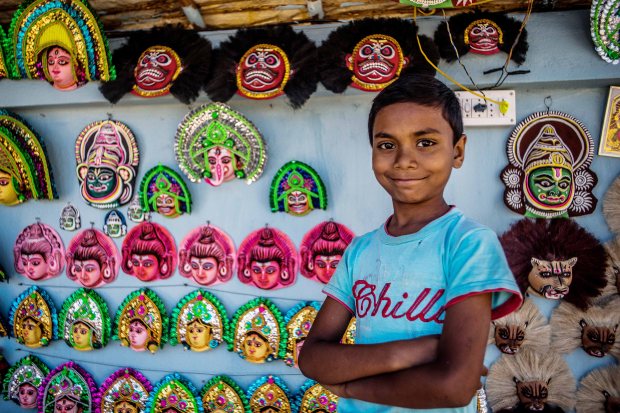
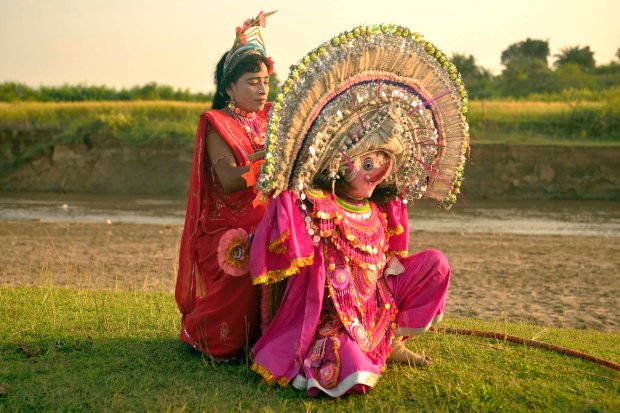
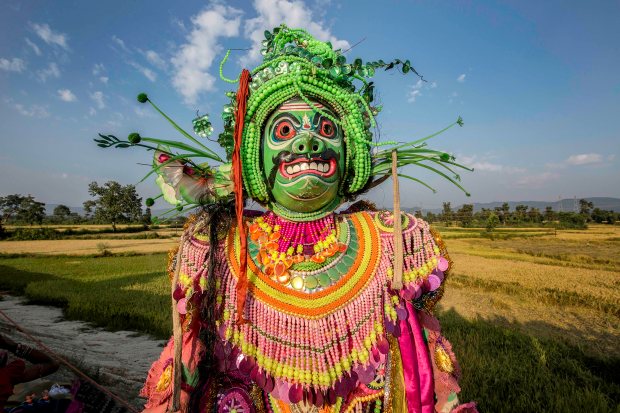
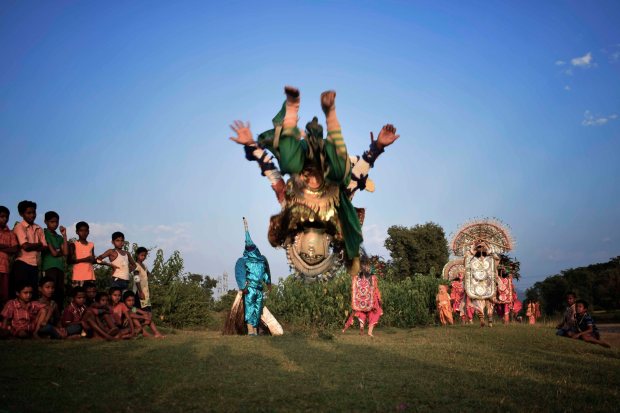

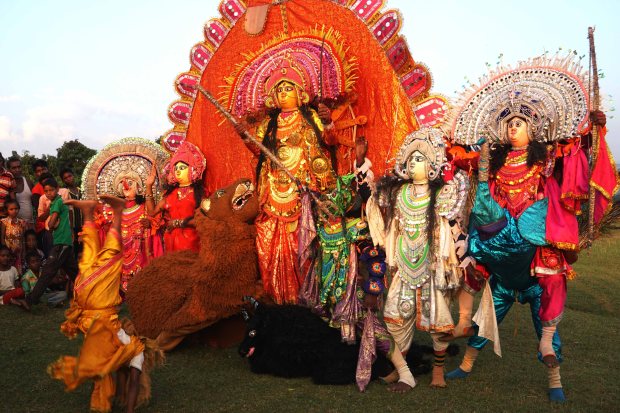

About the Curator
Born in the City of Joy, Kolkata, Indranil is always eager to travel to different places and document them with small write-ups and photography. He started with a small point and shoot, and his attempts got published in many travel magazines in Kolkata. To improve his skills and take it to a higher level, he joined Ram Krishna Mission Vidyamandira, Belur Math, Howrah, and did a certified course in Digital Photography. In 2012, he formed VIBGYOR (www.infovibgyor.com), along with few more friends in Kolkata, where, art enthusiasts are given various workshops to promote and pamper the passion. Photography is a major part of VIBGYOR, and many photo-walks and workshops were arranged for Kolkata enthusiasts. In January 2015, Indranil got transferred to Mumbai. He opened a new chapter of VIBGYOR in Mumbai, and soon, it flourished and gained popularity. Indranil continued conducting Photography workshops in Mumbai under the VIBGYOR Mumbai Chapter banner. Thereafter, there was no looking back. At present, VIBGYOR is now running in four different cities, including Bhubaneswar and Hyderabad.
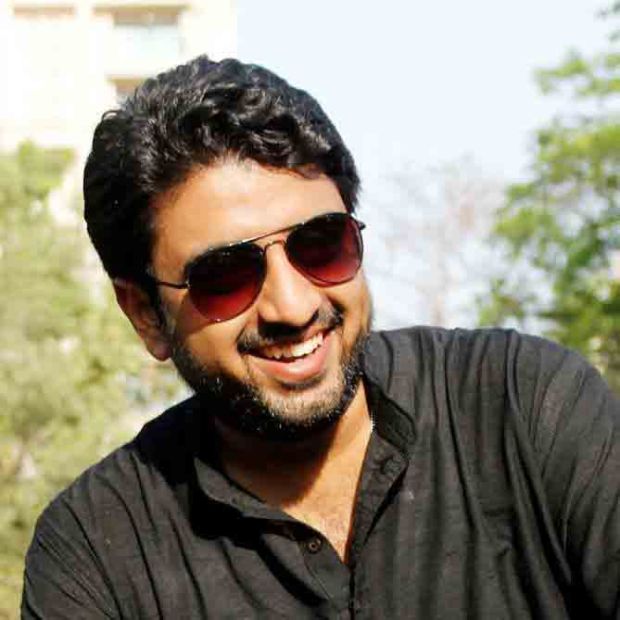
j4jishun@gmail.com
About VIBGYOR
VIBGYOR is a forum for Photography, Travel, and Heritage. As a brainchild of 4 friends, VIBGYOR started its journey in 2012. We are wanderers at heart and embark on exploring new and unknown territories.
Our country epitomizes cultural diversity in true sense and every part of India carries a unique historical and cultural heritage. VIBGYOR is passionate about engaging people with her rich culture through photography and travel.
We collect information, capture photographs, document, and present them in an appealing format. On our platform, you can enjoy photography, gather information about a palatial dilapidated building, an ancient temple or a tourist place and may discover some fascinating facts about a place, which you had not visited earlier. We stand in contrast to normal photography as our uniqueness lies in portraying information based visual account of a specific subject.
Although we started our journey in Kolkata, we also have active chapters in Mumbai, Bhubaneswar, and Hyderabad at present. Apart from these three operational cities, we accept invitations from other cities such as Sikkim, Mizoram, Ahmadabad to organise exclusive initiatives for the sake of Art.
Connect to VIBGYOR
www.infovibgyor.com
Mobile: 9920773284
vibgyorfob@gmail.com
www.facebook.com/infovibgyor
Instagram: @igvibgyor
Tweeter: @info_vibgyor
Bio:
Indranil Mukherjee is a photographer based in Mumbai. He is the founder of Vibgyor (www.infovibgyor.com).
***
For more stories, read Café Dissensus Everyday, the blog of Café Dissensus Magazine.






Reminds me of Dr Sonal Mansingh. She was the first Indian woman to perform Chhau. Being a semi classical dance it is very tough to perform on stage in front of 100+ audiences. I had performed way back in 1999 though my performance was not up to the mark. Folk dances are the toughest ones and that too when it blends martial, tribal and classical dance forms. The masks help in communicating to certain extent but each movement is a story telling, Kathakars the story tellers. Need to read this again. Must admit the locals are masters in this cult and we need to learn from them
“The liver performance soon gained additional momentum with summersaults and rapid movements and dance steps. The drum beats kept increasing, forcing all the viewers to tap their feet, add clapping, a chill running down the spine” – Similar like Manipuri Dance. The somersaults do make the audience a chill running down the spine.
The mask behind the performance – Even Kathakali is same. The masks are made by the locals and the masks are the stories with rapid eye movements. The stories of Mahabharata, somewhat similar to Chhau. All dance forms are similar. Indeed a good read